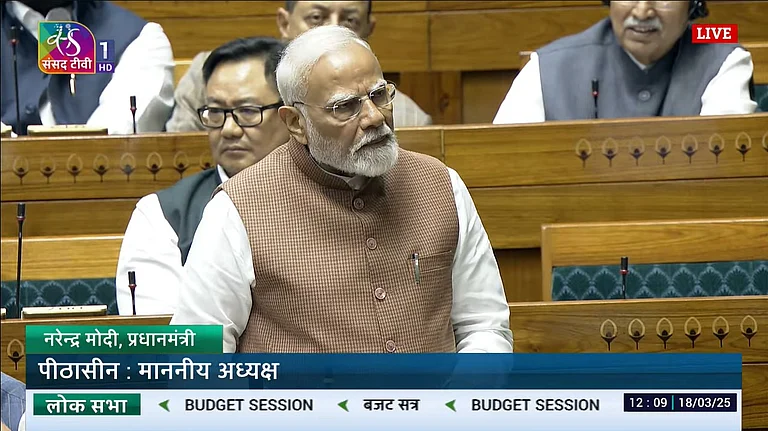After last week’s Rajya Sabha elections, the Bharatiya Janata Party (BJP)-led National Democratic Alliance (NDA) has inched close to the majority in the Upper House of the Parliament.
The NDA getting close to the majority-mark in the Rajya Sabha is being seen as a further sign of the political dominance of the BJP and the continuation of the diminishing electoral returns for the Opposition.
While the BJP has had a clear majority in the Lok Sabha since 2014, the party has not had a majority in the Rajya Sabha and has instead relied on coalition partners in the BJP-led NDA and support from unaligned regional parties like the Biju Janata Dal (BJS) or YSR Congress Party (YSCRCP). Now, however, the situation is such that the NDA is just three seats short of majority and the room for the Opposition to have any leverage against the Narendra Modi government in the lawmaking domain is next to none.
For the first time in 10 years, the BJP has reached this close to the majority-mark in the Rajya Sabha. Political observer Ramesh K Chauhan says this puts the relevance of the Opposition under further strain. He says the Rajya Sabha elections, which saw upsets for the Opposition bloc INDIA in Himachal Pradesh and Uttar Pradesh, are part of the broader inability of the Opposition to organise itself against the government in the past 10 years.
How BJP Stands Now In Rajya Sabha?
Following the last week’s Rajya Sabha elections, the BJP has inched closer to the majority-mark than ever in the past 10 years.
In the 245-member Upper House of the Parliament, the effective strength is 240 at the moment as four seats from Jammu and Kashmir and one nominated member’s seat are vacant. The seats in the J&K are vacant as the union territory (UT) —earlier a full-fledged state— has been without a legislative assembly since 2018 when the then-Governor Satyapal Malik dissolved the assembly months after Mehbooba Mufti resigned as the Chief Minister after the BJP withdrew support from the Mehbooba-led Peoples Democratic Party (PDP)-BJP government.
In the house with the effective strength of 240, the majority-mark is 121. After last week’s election results, the BJP-led NDA has 118 Rajya Sabha MPs, which means the coalition is just three seats short of the majority-mark.
Of the 56 seats that went to polls, 41 were won uncontested and polls were held on 15 seats. Of these 56 seats, the BJP won 30. With these 30 seats, the BJP’s tally in the Rajya Sabha reached 97 and the NDA’s tally reached 118, according to NDTV.
This means that the BJP will now have a much easier time in clearing bills in the Rajya Sabha. In the first term of the Modi government, a number of bills were halted in the Rajya Sabha because of insufficient numbers. “Till 2019, several bills —including the land reform and Triple Talaq Bills of 2017 and 2018— got blocked by the Opposition in the Upper House. While the land reform bill was not re-introduced, the government went ahead to pass the bill against Triple Talaq in its second term,” noted Akhilesh Sharma in an article for NDTV.
How BJP Navigates Rajya Sabha Without Majority
While the BJP has now inched closer to majority in the Rajya Sabha, it still does not have a clear majority.
Over the past 10 years, the BJP has relied on unaligned regional parties like the Biju Janata Dal (BJD) and YSR Congress Party (YSRCP) to clear bills in the Rajya Sabha in the absence of a clear majority. Recently, this was most notably visible during the passage of the contentious National Capital Territory of Delhi (Amendment) Bill, 2023, commonly called the Delhi Services Bill.
While the Opposition bloc INDIA had brought even ailing members like former Prime Minister Manmohan Singh and Jharkhand Mukti Morcha (JMM) leader Shibu Soren to boost their numbers to the fullest, the BJP was counting on unaligned regional parties like the BJD and YSRCP. The INDIA bloc also lacked the numbers and was relying on parties like the Bharat Rashtra Samiti (BRS).
At the time of the passage of the Delhi services bill, the Janata Dal-United (JD-U) was also with the INDIA bloc. Now, the JD (U) has jumped ship to join the BJP-led NDA, so that has further boosted the coalition’s standing in the Rajya Sabha.
What Do Rajya Sabha Election Results Mean For Opposition?
In the Lok Sabha, since the BJP has a clear majority, the Opposition has been largely marginalised for the past 10 years. Now, such marginalisation is also around the corner for the Opposition in the Rajya Sabha.
Since the BJP is almost assured of broad support from at least BJD on a range of bills, the BJP-led NDA effectively has enough numbers to sail its electoral agenda through the Rajya Sabha without any hiccups.
Shimla-based Political observer Ramesh K Chauhan says that the Opposition has been able to furnish voters with an alternative to the BJP in the past 10 years and it has led to heightened scepticism. While he sees Rajya Sabha upsets as part of this broad inability, he attributes the cross-voting in Himachal Pradesh to localised factors.
In last week’s Rajya Sabha polls, six Congress MLAs and three Independents cross-voted in favour of the BJP in Himachal and seven SP MLAs cross-voted in favour of the BJP in UP. This meant that the BJP won eight of the 10 seats in UP against the expected seven seats and the BJP won the only seat up for polls in Himachal which it was not supposed to win had the Congress MLAs not cross-voted.
As for the embarrassment in Himachal, Chauhan says that it was more of a revolt of the MLAs against their chief minister instead of an expression of support for the BJP.
“The dissenting votes in Himachal signalled a rebellion against CM Sukhvinder Singh Sukhu rather than an endorsement of the BJP. The Congress High Command perceived Sukhu as a ‘commoner’ leader, relatable to the state’s populace. However, this perception proved to be flawed. Succeeding the towering Virbhadra Singh, who wielded a larger-than-life influence for over three decades in the state, Sukhu faced an uphill task. Virbhadra was the uncontested party leader for over three decades and had a political career spanning six decades. This is a feat largely unparalleled even on the national stage. Sukhu lacks the popular mandate Virbhadra enjoyed and found himself at odds with the MLAs,” says Chauhan, Professor, Department of Political Science, Himachal Pradesh University.
Chauhan further contends that interpreting the Congress victory in the 2022 Himachal elections as a triumph is misguided. He says it was a response against the BJP fueled by anti-incumbency rather than an endorsement of the Congress.
“Virbhadra was a leader whereas Sukhu has always been more of a follower. It will be very difficult for him to complete a five-year full term,” says Chauhan.
As for the cross-voting in UP, Chauhan highlights that the case there is the exact opposite of Himachal. While the MLAs of the ruling party rebelled against their own chief minister in Himachal, Opposition MLAs voted in favour of the ruling party in UP which is more of a norm as far as cross-voting trends are concerned, notes Chauhan. A similar situation was also seen in Karnataka where the ruling Congress party won three of the four seats up for polls against the expected two. While the BJP won the fourth seat, its coalition partner Janata Dal-Secular (JD-S) lost, which is understood to be a result of cross-voting in the favour of Congress.
While Chauhan attributes the embarrassment of the Congress in Himachal to local dynamics, he underscores the broader failure of the Opposition to furnish a viable alternative to the BJP. He says the Rajya Sabha election results further marginalise the Opposition.
“There is neither any pervasive anti-incumbency against the Modi government nor there is a well-orchestrated Opposition movement. Typically, these elements emerge in the second term of any government, like the BJP’s movement and anti-incumbency due to corruption issues against the Congress-led UPA government in its second term. The Congress led by Rahul Gandhi has failed to present a cohesive front. Regional parties are incapable of challenging the BJP. This leaves the Congress as the sole national entity poised to counter the BJP. However, internal disarray has hindered the Congress from organising a formidable opposition. This leaves the Opposition without a cohesive structure or a coherent narrative to present to the electorate,” says Chauhan.

























